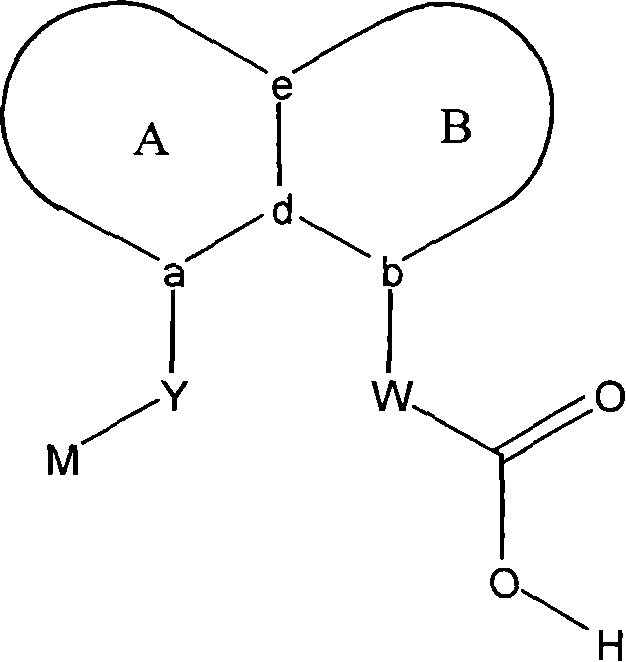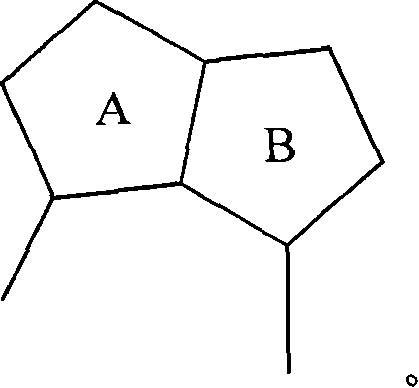Carboxylic acid peri-substituted bicyclics for occlusive artery disease
A technology of compounds and substituents, which is applied in the field of bicyclic acid compounds with perpositional substitution, can solve the problems of increased local concentration and low circulation level of prostaglandins, and achieve the effect of treating inflammatory diseases
- Summary
- Abstract
- Description
- Claims
- Application Information
AI Technical Summary
Problems solved by technology
Method used
Image
Examples
Embodiment 1
[0159] Example 1. Preparation of A25.
[0160] 2-Fluoro-6-(naphthalen-2-yloxy)-benzonitrile (K-1): To a 20 mL vial containing a magnetic stir bar was added sodium hydride (103.7 mg, 4.32 mmol, 60% in mineral oil middle), followed by addition of anhydrous DMF (2 mL), resulting in gas evolution. To the stirred reaction mixture was added 2-naphthol (623 mg, 4.32 mmol) as a solid in small portions over a period of 5 minutes. The mixture was stirred at room temperature for 3 minutes, then a solution of 2,6-difluorobenzonitrile (601 mg, 4.32 mmol) in anhydrous DMF (4 mL) was added in one portion. The reaction mixture was heated at 100° C. in an oil bath for a total of 2 hours, then cooled to room temperature. The reaction mixture was diluted with water (15 mL), and the resulting mixture was extracted with EtOAc (2 x 20 mL). The combined organic extracts were washed with water (3 × 20 mL), dried (Na 2 SO 4 ), filtered and concentrated to give brown solid K-1 (1.216 g) (containin...
Embodiment 2
[0164] Example 2. Preparation of A26.
[0165] 4-Iodo-1-methyl-1H-indazol-3-ylamine (K-4): To a 50 mL pressure vessel was added 2-fluoro-6-iodobenzonitrile (500 mg, 2.02 mmol) and N,N - Dimethylacetamide (5 mL). To the stirred solution was added methylhydrazine (139 μL, 2.63 mmol), and the sealed vessel was heated to 80° C. for 2 hours, followed by heating at 120° C. for 16 hours. The cooled reaction mixture was diluted with water and extracted with EtOAc (3x). The combined organic extracts were washed with water and dried (Na 2 SO 4 ), filtered and concentrated. The resulting semi-solid material was triturated with hexane / EtOAc (1:1), and the resulting solid was filtered, washed with EtOAc and dried. This operation gave 149 mg of a light brown solid. The aqueous washes from the previous step were extracted with EtOAc to give an additional 327 mg of product. Total yield was 476 mg (85%) of K-4. 1H NMR, MS.
[0166] Naphthalene-2-carboxylic acid (4-iodo-1-methyl-1H-inda...
Embodiment 3
[0169] Example 3. Preparation of A02.
[0170] Synthesis of ethyl 5-amino-1-(2,2-diethoxy-ethyl)-1H-pyrazole-4-carboxylate, K-7: Hydrazine hydrate (17.5 mL, 0.355 moles) in 60 mL Bromoacetaldehyde diethyl acetal (20 g, 0.101 moles) was added dropwise to a stirred solution at reflux temperature in absolute ethanol, and the resulting mixture was heated at reflux overnight. The cooled reaction mixture was concentrated in vacuo, then 35% aqueous NaOH (25 mL) containing 3 g NaCl was added, and the solution was extracted with diethyl ether (2 x 100 mL). Combined organic phases in MgSO 4 Drying on celite and concentration in vacuo afforded 12.3 g of an oil. To a solution of this crude product (2,2-diethoxy-ethyl)-hydrazine (12.3 g, 0.0831 moles) in 25 mL of absolute ethanol was added ethylethoxymethylene cyanoacetate ( 14g, 0.0831moles) in 75mL of absolute ethanol. The mixture was stirred at room temperature for 3 days. The solvent was removed and the oily crude residue K-7 was ...
PUM
| Property | Measurement | Unit |
|---|---|---|
| mass | aaaaa | aaaaa |
Abstract
Description
Claims
Application Information
 Login to View More
Login to View More - R&D
- Intellectual Property
- Life Sciences
- Materials
- Tech Scout
- Unparalleled Data Quality
- Higher Quality Content
- 60% Fewer Hallucinations
Browse by: Latest US Patents, China's latest patents, Technical Efficacy Thesaurus, Application Domain, Technology Topic, Popular Technical Reports.
© 2025 PatSnap. All rights reserved.Legal|Privacy policy|Modern Slavery Act Transparency Statement|Sitemap|About US| Contact US: help@patsnap.com



